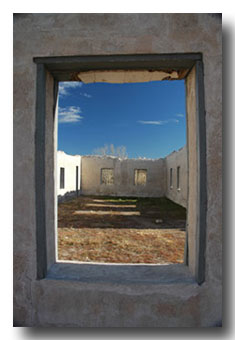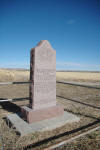| Friends Of The Little Bighorn Battlefield |
The Next Generation In The Study Of Custer's Last Stand |
Ft. Laramie |
| • The Battle • Archeology • Memorials • Little Bighorn Store • News • Book Reviews |
Ft. Laramie: Military Bastion of the High PlainsBy Douglas McChristianBook Review by Bob Reece, April 2012All photos © Bob Reece unless otherwise noted
A peak inside one of the structures at Fort Laramie "Fort Laramie: Military Bastion of the High Plains" reports the truth that the fort was far from the Hollywood image of a military fort housed behind timbered walls. Instead, it would evolve into an open sprawling village filled with colorful characters. Whether it was a trading post or a fort of the U.S. military, it stood on the edge of civilization and acted as gateway to some of the most traveled roads in U.S. history, west and east. To the wearied traveler, Fort Laramie was the last bastion of shelter in the American West.I can almost imagine those brave souls and their last forlorn glance back at the fort before it disappeared out of view to the east, or those searching for fortune in 1876 as they passed through on their way to the gold fields of the Black Hills. Sweeping and authoritative, "Fort Laramie" is a tour de force of the many characters that lived in or near the fort. They might be soldier or Indian or settler, but they all made Fort Laramie a colorful part of what it is today: George Crook, John Gibbon, John Grattan, John “Portugee” Phillips, Red Cloud, Charlie Reynolds, and Spotted Tail just to name a few. "Fort Laramie" is filled with scenes that enable the modern reader to better relate to the Frontier Army. We step back in time to experience life within the fort to its fullest, as in the celebrations of Christmas and the Fourth of July, or dinner parties as well as balls where dancing would last late into the night. In its early days, life was rough at Ft. Laramie, but the later years were filled with comfort for the officers and their families. Mr. McChristian even documents the colorful “hog ranches” that resided along the rivers outside the confines of the fort and the characters who prospered from them. Their names match their business: “Cutlet Jim” Converse and “Jack Nasty Jim” Wright. The book provides details of the fort's many structures that enable the reader to picture in their minds what the fort looked like. Officers Row, on the west side of the parade ground, included luxurious quarters – for a western fort – with “Old Bedlam” as its social center. It is at Old Bedlam where John “Portugee” Phillips would be taken to report the tragic news of the Fetterman Battle to Ft. Laramie’s officers.
To enlarge, click on Officers Row. Old Bedlam is the two story building
Soldier barracks The mood of the book becomes fateful as it fully chronicles the fort becoming center stage at the most important moments in the U.S. government’s relationship with the Plains Indians: the Treaties of 1851 and 1868, the location of the first agency to the Lakota, and the many peace councils. That relationship at Fort Laramie -- once fair -- grew sour over time, and Mr. McChristian does not tread lightly in its telling. He tells the story of the Grattan Fight of 1854 well but we also are privy to an even earlier fight that was the true harbinger of bad blood between the Indians and the Army. The Flemming Affair occurred a year before Grattan and Conquering Bear met their fates. Second Lieutenant Hugh Fleming was ordered to go to the Miniconjou village of Little Brave and arrest a warrior who had harassed emigrants along the trail, as well as shot at a sergeant while crossing the Platte River on its ferry. Instead of making an arrest, Fleming’s soldiers spilled first blood when a small fire fight resulted in at least four of Little Brave’s warriors killed. No wonder there was immediate tension in Conquering Bear’s village a year later when Grattan brought his soldiers there. Monument near the Grattan Fight site Long after the Indian wars were over, the residents of the fort dealt with new adversaries like the rogue white outlaws who robbed the coaches filled with payloads of gold from the Black Hills. But, the toughest adversary they could not conquer was time. Mr. McChristian vividly recounts the last days of the fort as its populace dwindled and its buildings slowly decayed. However, he gives us a happy ending to a remarkable study when Fort Laramie becomes a unit of the National Park Service on March 31, 1937. Simply stated, Mr. McChristian is the epitome of an historian. He thoroughly navigates the reader through a wonderful journey from trading post to an expansive military fort with ease. Most important, he understands those souls that inhabited or visited Fort Laramie better than anyone, and our lives are enriched from getting to know them. “Fort Laramie: Military Bastion of the High Plains” includes a foreword by Paul Hedren, 28 maps and illustrations, and an appendix, “Regiments Represented in the Fort Laramie Garrison, 1849-1890. More InformationFort Laramie National Historic Site Fort Laramie Historical Association Interview with Douglas McChristian Books On The Horizon Home |
|
|||
|
Copyright 1999-2013 Bob Reece Friends Little Bighorn Battlefield, P.O. Box 636, Crow Agency, MT 59022 | Home |
Board of Directors |
Guest Book | Contact | Site Map
| |
||||



